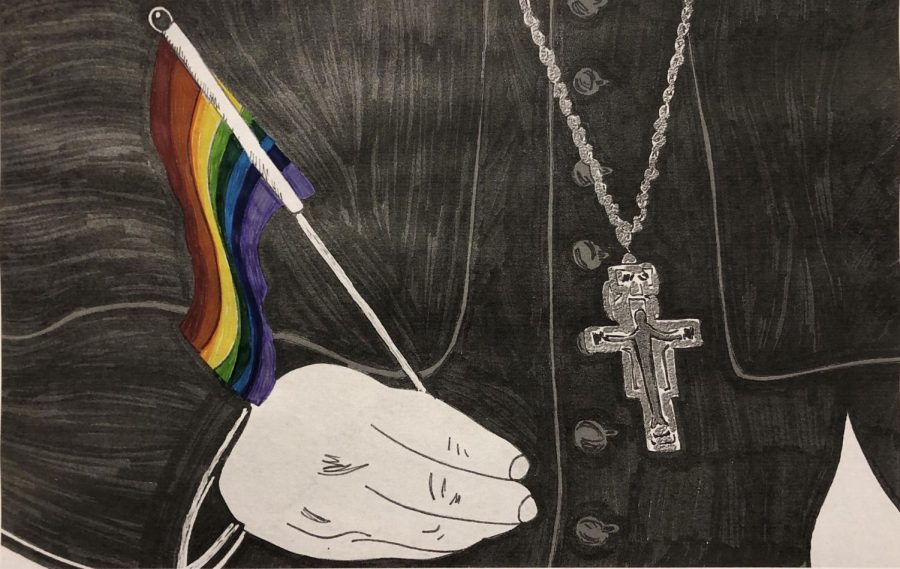Issues of morality and sexual identity have become increasingly contrasted to religious beliefs, as the theme of sexuality versus faith is more commonplace in popular culture and even politics in the modern world. It creates a bitter divide between the two, which in turn creates intolerance and disrespect when they deserve to coexist peacefully.
Vice President Mike Pence’s Focus on the Family initiative takes a conservative stance in addressing abortion, birth control and homosexuality, among other topics. Arguing that “Christians are so under-represented and LGBT-identified people so over-represented in news and media,” Pence’s program adds to a nationwide split between beliefs about sexuality and religion.
But there is some truth to Focus on the Family’s disappointment in the representation of Christians—especially Catholics—in the media. The theme of sexuality versus faith has carried over to popular culture, as television shows and movies often mischaracterize Catholic characters, reducing them to their stereotypes.
One such example is the depiction of Danny Castellano in “The Mindy Project.” An Italian Catholic from Staten Island, his faith is portrayed on screen as a strange combination of caring and comical. The password to his computer is either ‘thatstatenkid’ or ‘vatican1forever,’ further perpetuating the cliché of the devout Catholic who won’t stop talking about his faith. Yet he’s also exposed as a hypocrite, cheating on his fiancé twice in one day while joking that “since technically it was the same day it’s really just the one sin.” His character is a blatant example of how the media has created a false understanding of Catholics and other religious groups by perpetuating seemingly harmless stereotypes.
The poor portrayal of Castellano and many other Catholic characters in television and movies can be seen as a reflection of the significant decrease in religious faith among younger generations. In a March Bark survey, when asked their religion, 31 percent of students self-reported that they are Catholic, while 12 percent are Jewish. Forty-three percent self-reported that they do not identify with any religion, and the remaining 14 percent identified as another religion. This theme of not identifying with a religion extends beyond just Redwood. A 2015 Pew Research Center poll reported that 34 to 36 percent of millennials do not identify with a religion, adding that this was a dramatic increase from 2007, when only 16 percent of Americans said they were affiliated with no religion.
There is often a grave mischaracterization of Catholics in popular culture, but there are people defying the stereotypes to allow the coexistence of faith and sexuality. Jane the Virgin, the popular CW television show, takes a refreshing and unusual perspective on Catholic sexuality. Jane, the show’s starring character, struggles with her chastity, guided in different directions by her sternly Catholic grandmother and her less religious mother. Jane lives her life by virtue, but strays from the clichéd devout Catholic lifestyle. Her character is multi-dimensional, and her faith is only a part of the complex person that she is. The show pokes fun at other Catholic clichés (and Spanish telenovelas) in a way that challenges popular belief and attempts to bridge the gap between sexuality and religion in the modern era.
Conservative groups like Focus on the Family are angered by their “under-representation” in the media, but they should be more worried about their mischaracterization. Their misdirected anger has dangerous results for members of the LGBTQ+ community because the stereotypes of both Catholics and LGBTQ+s creates an irreconcilable division between sexuality and religion, though the two are often intertwined.
The changing impact of the media in beliefs about religion and sexual orientation is reflected in the results of the Bark’s March 2019 sex survey.
The survey asked students if they believe homosexuality is morally wrong. Twelve percent of Catholics responded “yes.” When asked the same question, 10 percent of Protestants and only seven percent of those not associated with a religion responded yes. One hundred percent of Jews responded that homosexuality is morally okay. In all, 10 percent of students self-reported that they believe homosexuality is wrong. The results of this survey reflect a growing intolerance of LGBTQ+ in the rest of the country in the last three years. In early 2018, the Gay & Lesbian Alliance Against Defamation—the media advocacy group for LGBTQ+ people—released the results of its annual “Accelerating Acceptance” survey.
The survey measures intolerance of LGBTQ+ and the results showed that people are right back where they were in 2014, as if all the progress made for the LGBTQ+ community during the Obama administration—banning conversion therapy, repealing Don’t Ask, Don’t Tell, legalizing same-sex marriage—never happened. And in the past year, the number of LGBTQ+ people reporting discrimination on the basis of their sexuality or gender identity has increased to 55 percent in 2017 from 44 percent in 2016.
The popular theme of God versus sexuality has seeped into movies, TV shows, and even legislation, which has had a dramatic effect on how Americans today identify themselves religiously and sexually. In 2019, somehow it seems like we’ve taken steps backward in our tolerance of both religion and sexuality. The media and popular culture have led people to believe that the two must exist as separate, sparring entities, but such a contrast damages their peaceful coexistence.





